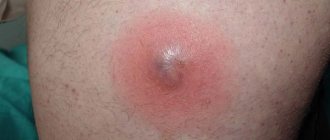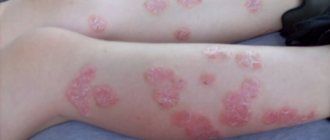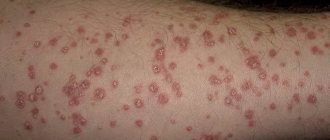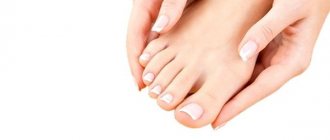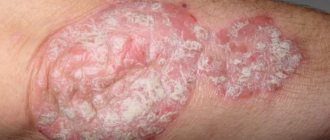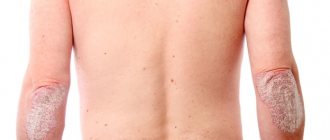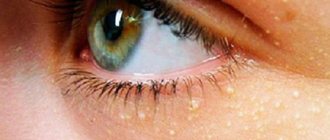Psoriasis on the face differs from the pathological process of other parts of the body in the thinness and sensitivity of the skin, which implies a more thorough approach to treatment. Most often the forehead area, nasolabial triangle and skin around the eyes are affected.
The course of the disease on the face is accompanied by a considerable number of symptoms and possible complications. Among other things, facial psoriasis significantly complicates the patient’s life, at least by reducing self-esteem and developing complexes about appearance.
Causes of psoriasis on the face
Facial skin psoriasis occurs due to overactivity of immune system cells, better known as T lymphocytes. Under normal conditions, they protect the human body from the effects of various foreign agents, such as bacteria, viruses or even allergens.
During a pathological process, signals are “erroneously” sent for the accumulation and subsequent activity of T-lymphocytes, although no foreign influence was exerted on the body. As a result, the main cells of the immune system, together with other cellular elements, lead to the development of an inflammatory response, which causes accelerated proliferation of skin cells.
The lesion is rarely localized selectively on the face. Often, psoriasis occurs on the scalp or other parts of the body.
The reasons associated with the development of facial psoriasis are the same as for other localizations of the disease. And although there is no practical confirmation of the causes of the disease, and most experts are based only on theoretical data, the following are considered to be the main predisposing factors:
- Family history: any close relative has a similar disease.
- Indication of a previous infectious dermatological process.
- Trauma to the skin, including surgical interventions.
- Stress and strong emotional experiences.
- Hormonal imbalance and endocrine diseases.
Psoriasis: contagious or not, routes of transmission of psoriasis
Psoriasis due to nerves: prevention and treatment
Often, patients may notice a worsening of symptoms after exposure to ultraviolet radiation: natural from the sun or after treatments in a solarium.
Smoking has a certain negative effect on the course of the disease.
Diagnosis of psoriasis on the face
Establishing the correct diagnosis is usually not difficult for an experienced doctor. Diagnosis is based on the clinical picture and study of the history of the disease. In addition to being examined by a doctor, a complete blood test and ultrasound examination are recommended. In doubtful cases, a biopsy of the affected area may be performed.
The psoriatic triad, which is carried out in the form of scraping pathological areas of the skin, has a certain diagnostic value:
- The phenomenon of stearin stain: initially, increased peeling is observed.
- Terminal film phenomenon: then the peeling stops, and in its place a smooth surface can be seen.
- The phenomenon of blood dew: the appearance of small drops of blood at the site of scraping.
Differential diagnosis is usually carried out with chronic dermatitis, some types of lichen and fungal infection.
Symptoms and first signs of facial psoriasis
What does psoriasis look like on the face? The skin lesions have a characteristic reddish-purple hue that can be itchy and accompanied by silvery-white scales.
The disease often occurs as a result of previous psoriasis of the scalp. Patients may notice the appearance of copious amounts of dandruff in the hair; in this case, dead cells of the epidermis (outer layer of skin) are mistaken for dandruff.
What does psoriasis look like on the face?
The preferred localization of the process is as follows:
- Skin between the upper lip and nose.
- Eyebrow area.
- Forehead skin.
- Involvement of the hairline area in the process.
- Psoriasis of the inside of the nose and ears.
- In some cases, psoriasis affects the lips, cheeks and gums, severely impairing the ability to chew and swallow food.
With psoriasis on the face, one of the symptoms may be the spread of the process to the eyelids, moving even to the eyelashes with their subsequent turning up or down. This is usually accompanied by redness, swelling and keratinization of the affected area. In severe cases, an inflammatory process of the membranes of the eye develops.
Note! Rare clinical cases describe psoriasis directly of the eyeball!
What do the types of the disease look like?
Typically, psoriasis on the face manifests itself in the form of small papules, which are located in the area of the nasolabial folds, eyebrows, and areas near the eyes. Other areas may also be affected, depending on the type of pathology.
The main symptoms of different types of illness:
Seborrheic
Lesions are isolated islands that are characterized by noticeable desquamation. They usually extend from the frontal area all the way to the scalp. However, this pathology can also manifest itself in the form of red eczema. On them you can notice purulent crusts that are prone to cracking. The seborrheic form is accompanied by severe itching, which causes severe discomfort to the patient.
Photo of the disease. May be unpleasant to watch
Pustular
First of all, the symptoms are the formation of blisters that are filled with a clear liquid. In addition to visual manifestations, you can notice a weakening of the immune system and a deterioration in metabolism.
teardrop-shaped
Reddish papules appear on the skin. Often they together form so-called plaques. These areas can have different shapes and sizes. This is one of the few forms of psoriasis that can affect almost any area of the skin.
Other types
The symptoms of other types of the disease are largely similar to the most common types.
Note! Often the pathology manifests itself as an allergy, so it is not easy to diagnose it at an early stage.
The rash can come in many forms, but usually causes itching or even pain on the face.
Photo of the disease. May be unpleasant to watch

Are there any features of psoriasis on the face in children?
The clinical manifestations of pathology in children are not much different from the symptoms in adults. But here the disease often manifests itself in an atypical form, which significantly complicates the diagnostic process. In addition, facial skin lesions in children can have more serious consequences.
Stages of the disease
For ease of understanding the pathological process and monitoring dynamics, it was proposed to use a clinical classification of the condition:
- Progress. The stage involves the initial stage of the process, during which the appearance of plaques, papules and other elements is observed with the possibility of subsequent fusion into larger lesions. Spots on the face with psoriasis become red in color and are accompanied by intense itching.
- Stabilization. Often observed during therapeutic measures; the appearance of new elements of the rash is not observed. Previous lesions may take on a bluish-purple hue, and the itching of the skin may lessen, but not completely disappear.
- Regression. Serves as an indicator of the effectiveness of the treatment. Symptoms and signs of psoriasis on the face thin out, the affected areas become paler, and peeling and itching practically do not bother the patient.

Progress
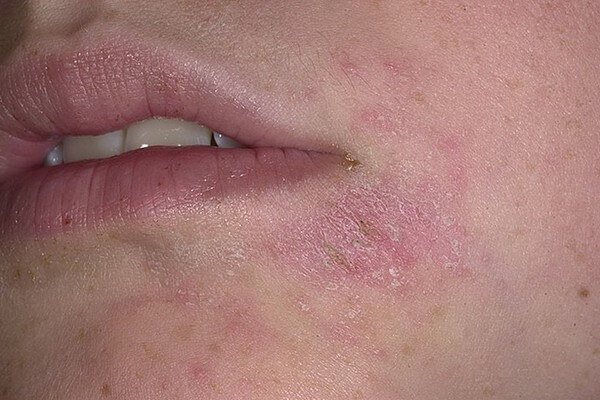
Stabilization
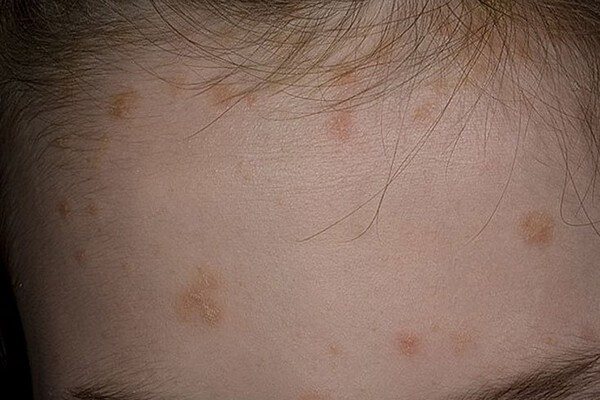
Stages of psoriasis on the face
Proper skin care for psoriasis

When washing and cleansing the face with psoriasis, it is necessary to use cosmetics for sensitive skin.
During the stages of exacerbation of the disease, skin care should be as gentle and careful as possible. Under no circumstances should facial skin be injured.
Recommendations for proper skin care:
- When washing, use products suitable for sensitive skin.
- It is not recommended to wipe your face. It is enough to dip the skin with a napkin, let it dry and apply a rich cream.
- When going outside, it is recommended to use additional skin protection: in winter, protect from snow and frost, in summer - from direct sunlight. However, skin affected by psoriasis must be exposed to air and sun.
- It is best to avoid using cosmetics. Men should replace their razor with an electric razor, which is less damaging to the skin.
Treatment methods for psoriasis on the face
When wondering how to get rid of psoriasis on the face, you need to know about the existence of several main types of treatment specifically designed for such localization of the process. Therapy is complicated by the fact that the skin of this area is thin and sensitive.

For facial psoriasis, ointments, creams and gels are mainly recommended. Here are some tips for their rational use:
- Use the product in small dosages.
- Be careful with the skin around the eyes: the mechanical impact should be gentle and your hands should be clean.
- Follow your doctor's recommendations to prevent side effects from medications (especially corticosteroids). In some cases, you will need to avoid makeup.
- If the chosen medication is ineffective or a side effect occurs, the question of correcting the therapy is raised.
The type of treatment chosen depends on the specific location of the process:
- Psoriasis on the eyelids. For this area, the doctor recommends ointments based on corticosteroids, but they can only be used for a while - glaucoma or cataracts are often noted as side effects. An alternative is topical pimecrolimus (Elidel), tacrolimus (Protopic), or crisaborole (Eucrisa). The listed ointments do not cause side effects like steroids. Upon initial use, a burning sensation is felt in the eyes. If an eye infection occurs, antibiotic therapy is recommended.
- Ears. The danger of the pathological process lies in the possible blockage of the ear canal, which can lead to partial or complete hearing loss. Among the recommended ointments are steroid and Calcipotriene.
- Damage to the mouth and nose. In addition to corticosteroid ointments (usually hydrocortisone), saline rinsing is often used to relieve pain. Elidel or Protopic is also used.
There is no reliable scientific evidence on the benefits of phototherapy for facial psoriasis. Most experts recommend low-intensity insolation, which helps slow down cell division.
Stages and their signs
The development of skin disease on the face occurs rapidly, since the skin in this area is very thin and susceptible. First, papules appear on a person’s skin - rashes similar to acne marks. Their occurrence is accompanied by a characteristic itching, which only intensifies over time. Papules increase in size and dry plaques form. Along with these processes, seborrheic psoriasis appears, localized on the forehead, behind the ears and along the hairline.
How to determine the stage of development of the disease? To do this, you need to carefully remove the scales from the plaques and examine the skin underneath them. The following conditions are characteristic of the damaged surface of the face at different stages of psoriasis development:
- Under the scales there is white skin: papular psoriasis. The initial stage of development, which is characterized by small rashes on certain areas of the face.
- The surface of the skin under the rash is bright red. At this stage, sebopsoriasis (seborrheic) is added. The red and scarlet surface is a terminal film that stops bleeding.
- If, after scraping, droplets of blood appear on the surface of the skin, it means that psoriasis is in the last stage of its development.
Also on the topic: Seborrheic psoriasis - how to treat it, causes?
The disease can be localized in the following places:
- on the eyelids and eyebrows;
- On the nose;
- on the forehead;
- in the mouth - on the lips and tongue.
In rare cases, psoriasis spreads to the iris and eyeball. You can see what dermatosis looks like on the face in the photo.
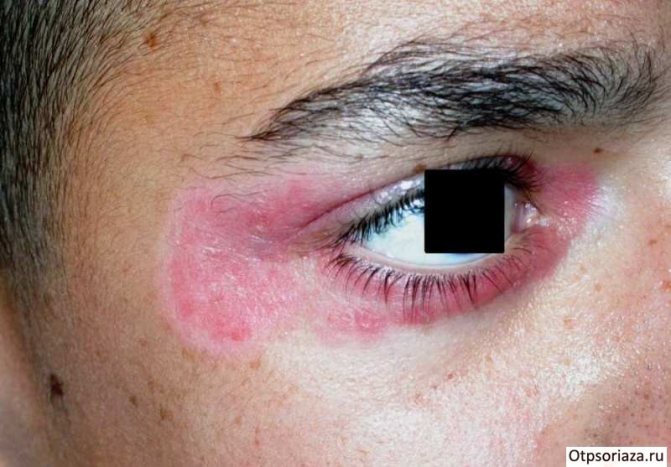
Psoriasis affects any part of the face
Drugs for the treatment of psoriasis on the face
The main medications for psoriasis are the following ointments and gels:
- A low-potency corticosteroid is a treatment for facial psoriasis. Ointments relieve redness and swelling. They are usually used for about two weeks, as they can cause a number of side effects: the skin becomes thin, shiny and bruises may appear more often. Steroids are available in ointment, gel, lotion, or spray form. A prominent representative is hydrocortisone ointment.
- Synthetic vitamin D. Slows down the proliferation of skin cells, does not have a wide range of side effects and is easier to tolerate by patients with sensitive skin. Representatives are Daivonex, Sorilux and Rocaltrol.
- Retinoids. They relieve inflammation and facilitate the removal of scales, but have unpleasant side effects - they irritate the skin. The most popular remedy is Tazorac.
Elidel and Protopic are FDA approved for the treatment of eczema. At the same time, some experts recommend the use of these ointments for facial psoriasis.
It is important to consult with your doctor about the rational use of these products, since some studies link the ointments presented with the development of the oncological process.
Crisaborole is another FDA-recommended ointment that can reduce skin inflammation. One of the side effects is burning of the skin.
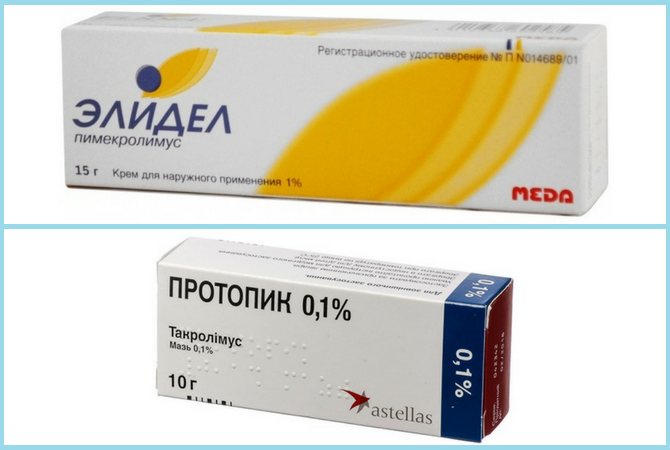
As psoriasis on the face progresses, treatment includes oral forms of medications:
- Apremilast (Otezla).
- Cyclosporine (Neoral).
- Methotrexate.
- Low doses of retinoids.
- Biological drugs: adalimumab, infliximab and others.
Each remedy works differently and is typically used for moderate to severe psoriasis.
Treatment
The first thing to do if you suspect this pathology on the face is to consult a dermatologist.
If psoriasis can be diagnosed at an early stage, it is more likely to be transferred to the attenuation stage. The choice of treatment is entirely made by the doctor, and depends on the type and severity of the pathology.
Photo of the disease. May be unpleasant to watch
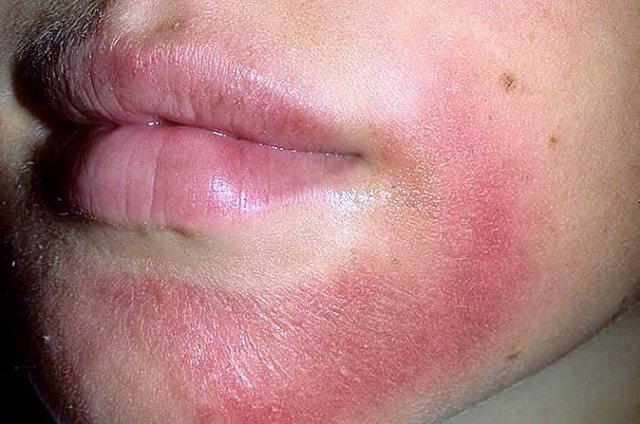
Drug therapy
Such medications are usually prescribed for severe cases of the disease. For example, in an advanced form with severe complications. The following groups of medications are distinguished here:
- cytostatic agents;
- immunosuppressants;
- aromatic retinoids;
- glucocorticosteroids;
- biologically active agents.
Any systemic medications are prescribed only by a doctor and only in a situation where external forms of exposure do not bring the desired effect. There can be no question of making an independent decision to use these drugs!
What is applicable at home
Simpler ways to treat psoriasis or relieve its symptoms can be done at home. Here you can highlight various ointments, creams, sprays or even folk remedies. However, even before such treatment, you should consult with a specialist to determine the appropriateness of certain medications.
Preparations for psoriasis on the face
Due to poor understanding of this pathology, there are many different approaches to its treatment. One of the most popular theories is the opinion that the acid-base level of the body changes after a lesion. Therefore, various acids are often used for treatment.
Hyaluronic acid
For psoriasis, low molecular weight hyaluronic acid is used. It perfectly helps cope with inflammation. In addition, this substance is often found in topical therapies.
Reamberin
Reamberin helps reduce the symptoms of psoriasis. Often, itching disappears, the exfoliation process decreases, and redness becomes less intense. In addition, it helps eliminate toxins.
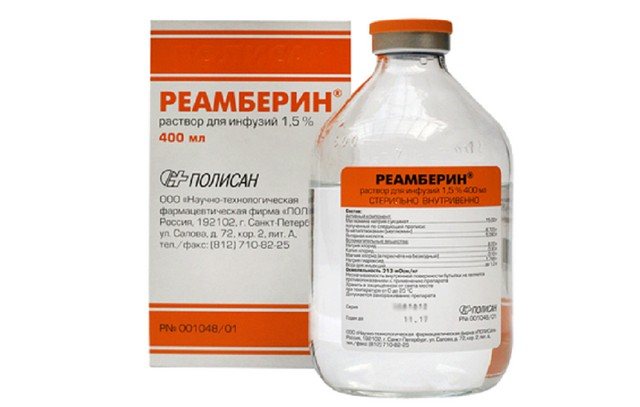
Other
Preparations containing lipoic acid are often used. It normalizes metabolism and has antioxidant properties. In some cases, it is appropriate to use nicotinic acid. It accelerates cell synthesis and alleviates the general symptoms of psoriasis.
Creams and ointments
Typically, patients choose the least invasive treatment methods. In such a situation, the best option is to use ointments or creams. The advantage of this method is its effect on the source of inflammation itself.
It should be understood that even the choice of ointment must be agreed upon with the attending physician.
Daivonex
Daivonex, first of all, normalizes the rate of cell division, which allows psoriatic plaques to resolve more quickly. However, it should not be used if the scale of the damage is too large.
Salicylic ointment
Salicylic ointment is distinguished by its significant cosmetic effect. She fights various inflammations. In particular, the ointment is used for psoriasis. In this case, treatment should be carried out in courses.
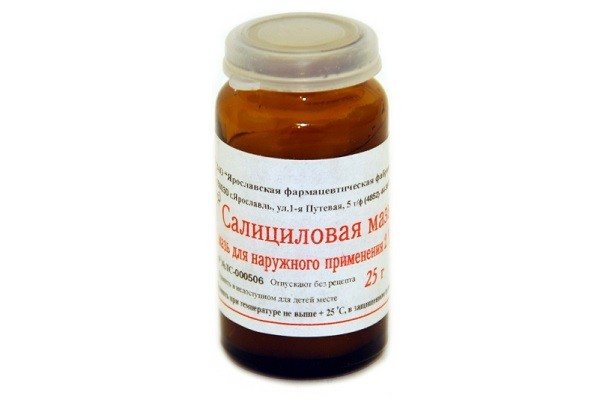
Attention! One of the key disadvantages of this remedy is the possibility of addiction.
In addition, an allergic reaction may occur to individual components of salicylic ointment. In addition, it is not able to cure the disease on its own, but only reduces the symptoms.
Other
For psoriasis, completely different ointments and creams are used. Akrustal is popular because it causes noticeable cosmetic improvements in patients. Zinc ointment is also often used. It has an anti-inflammatory effect. In addition, zinc accelerates cell regeneration.
Sprays
One of the most unpleasant elements of psoriasis is the cosmetic problem. Some patients feel self-doubt. In addition, the pathology often causes itching and pain. In this case, various sprays can relieve the symptoms. Imported products are usually popular. It is distinguished by high quality and safety. For example, a Spanish-made skin cap spray shows good efficiency and effectiveness. It helps restore the skin barrier and suppress the development of pathogenic fungi.
Use of oils
An unusual method of treatment is the use of oils.
They perfectly complement drug therapy and do not cause any harm to the body.
Of course, you should initially prevent the possibility of any allergic reactions. Both essential and edible oils are used for psoriasis.
Folk remedies
Traditional recipes are not able to cope with this pathology on their own. However, they may relieve psoriasis symptoms.
Moreover, sometimes it is possible to achieve a stable attenuation of the pathogenic process. There are several of the most popular folk methods that have actually proven their effectiveness.
- You can use lotions of water and salt (in a ratio of 3:1), which are applied to the affected areas.
- To relieve symptoms, you can apply a cotton pad soaked in coconut or lavender oil to the skin.
- Redness can be treated with sea buckthorn oil.
Among other things, it is recommended to adhere to a special diet and add the maximum amount of essential vitamins to your diet.
Traditional methods of treatment
The skin on the face is especially sensitive and thin and requires very careful treatment. Even folk remedies for the treatment of psoriasis on the face are selected carefully and carefully:
- Phytocollection. Take 300 g of nettle leaves and burdock roots, add 200 g of burdock roots, chop everything and mix. Pour 0.5 liters of boiling water 1 tbsp. l. collection, keep on low heat for 5 minutes, leave covered. Take 100 ml three times a day for 2 weeks, then take the same break.
- Lotions. For decoctions, take herbs: flaxseed, calendula, St. John's wort, string, etc. Make infusions in accordance with the instructions. Soak a clean cloth in the resulting solution, wring it out lightly and place it on the affected area for 10 minutes. Lotions are applied for an hour twice a day.
- Blue clay. They make baths, compresses, applications. For applications, the clay is mixed in half with coarse salt and slightly diluted with a decoction of the string. Apply over a cloth to the affected area. Leave for 2 hours and wash off with warm water.
Doctors recommend using alternative treatments during the remission stage, but some remedies are also effective during exacerbations. However, you should not ignore drug treatment.
How to treat at home?
Competent treatment consists of three main points:
- thorough skin care;
- diet;
- use of medications and traditional methods of therapy.
The patient does not have to give up all foods, but the consumption of junk food should be reduced to a minimum. The diet should be dominated by fruits and vegetables, which saturate the body with vitamins. It is also strongly recommended not to drink alcohol or smoke cigarettes. Bad habits provoke regular relapses.
If a person discovers that he has psoriasis, then, first of all, he should consult a dermatologist. The use of some drugs can affect the entire body, causing side symptoms and allergic reactions.
Pharmacy drugs
Treatment of psoriasis is carried out using a whole range of drugs for external and oral use. In some cases, the patient may be prescribed vitamin injections.
For therapy you will need:
- Ointments and creams. A good remedy is Akrustal - a phytocream based on bee honey and wax. This natural medicine can be taken without prior medical consultation, as it has no contraindications (except for individual intolerance). Cost for 65 grams: about 600 rubles. Ascorutin and Akriderm are also used to treat psoriasis.
- Pills. It is recommended to take vitamin complexes rather than hormonal medications. At the same time, instead of the advertised drug Complivit, you can buy cheaper Undevit (cost: about 70 rubles). Aevit and Methionine are also used for therapy.
- Injections. As a rule, vitamins B5 to B12 are injected.
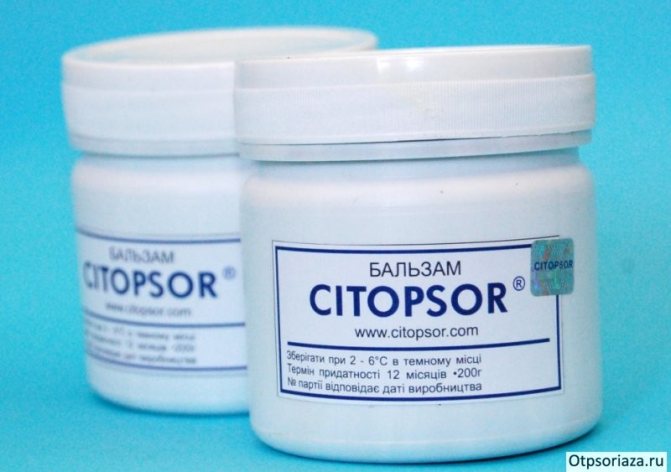
Cytopsor is based on solid oil
What should I apply to plaques to make them go away quickly? Products based on solid oil show good effectiveness. This is not only Akrustal cream, but also such drugs as: Kartalin, Antipsor, Cytopsor.
It is also recommended to take a closer look at Chinese ointments. Before using such products, you need to test for an allergic reaction. Chinese ointments can quickly remove rashes and relieve itching.
The following medications can be used to treat psoriasis in a child:
- salicylic ointment;
- Colloidin;
- Flucinar;
- Sinaflan.
Hormonal creams and tablets are used only for the treatment of dermatosis in adults. Such remedies are selected on an individual basis, as they have many contraindications. It is strictly not recommended to purchase and use hormonal medications on your own.
Folk remedies for psoriasis on the face
Traditional methods of treatment are used in conjunction with medications and increase the effectiveness of therapy. Such methods of combating psoriasis have no side effects. The only contraindication is intolerance to the components used. Any of the described recipes can only be used on cleansed skin.
Also on the topic: Guttate (drop-shaped or dotted) psoriasis
Birch tar and celandine
Birch tar is applied pointwise to the rashes.

Birch tar is an old remedy for treating psoriasis.
After an hour and a half, you need to wash it off with warm water and cover the plaques with celandine. It is best to use a tincture of water or alcohol.
To prepare it, you will need to take several fresh plant stems and 1 glass of liquid. Celandine must be crushed and added to water or alcohol. Instead of a fresh plant, you can use 2 tablespoons of dry herbs. The mixture should be infused for 3-4 hours.
Treatment of psoriasis with oils
The following oils are suitable for this method:
- lavender;
- coconut;
- juniper.
They can be used individually or mixed with each other.
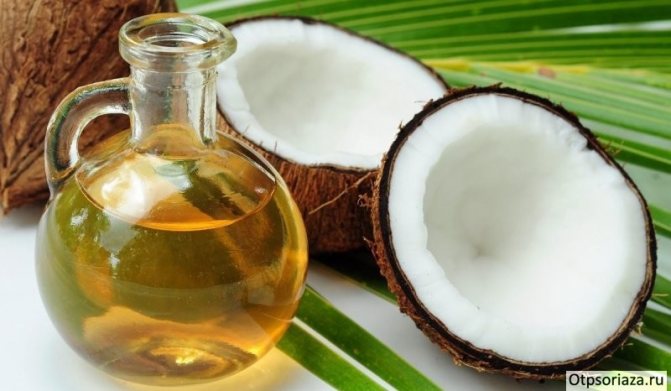
Coconut oil will help soften the skin and promote healing
Method of application: moisten a cotton pad with oil and apply it to damaged skin. Leave for 10-15 minutes.
Another effective way is to apply solid oil overnight. If you use these treatment methods together, the skin will stop itching and flaking, and the rashes will go away.
Hydrogen peroxide against dermatosis
Only a 3% solution can be used. It must be diluted with a small amount of water (proportions 1:3). Apply to plaques, do not rinse. Instead of peroxide, you can use dead sea salt, which also effectively fights dermatosis.
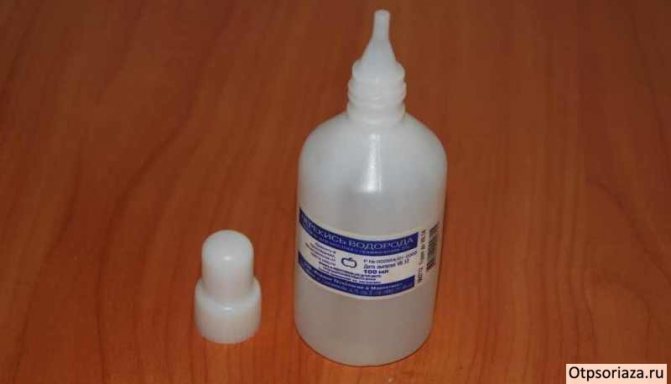
Use only 3% peroxide solution
Traditional methods of treatment should be used until visible results appear. The course of treatment takes from 3 days to 2 weeks.
Course of the disease
Like any psoriatic process, the disease is chronic and flows in waves, alternating stages of progress and regression of the rash. Neglect of the case and the lack of special treatment not only creates problems with the patient’s appearance, but also leads to various complications, including psoriatic arthritis.
With timely rational therapy, compliance with medical recommendations and avoidance of all kinds of triggers (stress, as an example), the prognosis for the disease is quite favorable.
The disease not only worsens the condition of the skin, but also affects the psychological status of a person, contributing to the development of anxiety and depression. Stress and anxiety, in turn, lead to the progression of psoriasis.
Prevention of psoriasis on the face
Patients with this form of the disease usually consider their condition to be the worst, given how psoriasis appears on the face. Appearance makes it difficult to meet new people or negatively affects your attempt to find a job. You can’t despair - psoriasis is only a part of a person and far from the main one.
It is necessary to share problems with friends or family, this will help psychologically. You can resort to the help of special support groups or consultation with a psychologist. Here are some general recommendations:
- Regular maintenance of physical fitness can help you cope with stress: sport helps reduce stress and improves your mood. Try to follow a daily routine, get enough sleep and learn proper nutrition.
- Reconsider your professional abilities. In some cases, the best option is to change jobs, especially if work activity could be accompanied by stress, exposure to allergens or various chemicals.
- Review the list of medications you are taking for concomitant pathologies; Check with your doctor about the safety of these medications.
- In some cases, patients benefit from a comprehensive intake of vitamins and dietary supplements
Conclusion
The localization of the process has two distinctive features: it is impossible to hide the rash under clothing, and the skin is much thinner than in other areas. That is why the treatment of psoriasis on the face requires a particularly careful approach - after all, any incorrectly used methods or medications can lead to a deterioration in appearance and aggravation of existing stress.
Timely treatment, as a rule, for any disease gives a favorable result - and therefore you should not neglect preventive examinations and unexpected tests. This will allow, even if symptoms appear, to get by only with local therapy, and if you follow the recommendations of a healthy lifestyle and eliminate the suspected causes, you will achieve stable and long-term remission.
